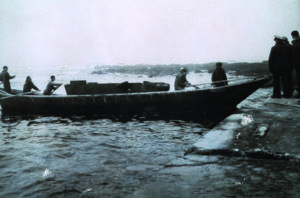Business & Education
The explorer who came in from the cold to wallow in squalour
This article is more than 9 years old.
How an Arctic hero’s documentation of the geography of Greenland went unheralded in Denmark until 134 years after his death

A umiak, just like the one Walløe used on his expedition. It was ideally suited to navigating shallow water and creeping up on unsuspecting harbour masters to ask for directions (photo: C&Gs Season’s report Pierce 1952)
Like sands through the hourglass, so are the days of our lives, and when they run out, few of us leave a visible trace. But in the same way that extreme weather might suddenly expose a forgotten settlement in the desert, the footprints left in the sands by 18th century Danish explorer Peder Olsen Walløe lay unseen for centuries until a historian in 1927 republished his diaries, bringing renewed attention to them.
The entries championed the efforts made by Walløe in Greenland between 1751 and 1753, during which time he documented much of the geography of the southern part of the island’s east coast – information that has since proved to be invaluable to those working and settling in the region.
Walløe first came to Greenland in 1739 as a colonialist – one of five recruited to the country by noted Lutheran missionary Hans Egede. Aged 23, he began an apprenticeship as a cooper – a traditional employment choice in pre-Industrial Revolution Europe. He learned to speak the Greenlandic language of Kalaallisut and qualified as a trader with permission to operate outside the Godthåb colony. He then worked for Cooper Colony Christianshåb from 1740-1742 before becoming a trading assistant in 1743.
Eastern exploration
But great explorers aren’t cut out to sit indoors all day. Walløe grew restless, and when an opportunity came to work for Jacob Severin, a Dano-Norwegian merchant nearing retirement, and actively take to the seas, he jumped at it.
It put Walløe in the right place at the right time. The same Mission College in Godthåb that had brought him over to the country in the first place recruited him to lead a five-man exploration team tasked with discovering the former Eastern Norse Settlement on the eastern coast of the island.
Walløe, along with two Danish sailors and two Inuit rowers, left Godthåb in August 1751 in an umiak – a native boat known for its ability to navigate the shallow waters commonly found between the coast and the sea ice. It enabled the expedition to successfully locate the Norse settlement identified by Egede along with the remains of other hitherto unknown settlements. The team were greatly assisted by Inuit locals who helped guide them to the settlements as well as brief them on the weather patterns of the region.
Over the first year, the team explored the area that later came to be known as Julianehåb District and the regions of Tunulliarfik Fjord and Hvalsey. And in 1752, they crossed Cape Farewell and travelled further up the east coast to an island, which Walløe called Nenese. They then went further north past the Lindenovs inlet but not much further due to the constant drift-ice and bad weather. The team ruled against returning the way they came and subsequently decided to return through the Prince Christian Sound – the shortest route for ships to avoid the rough waters around the tip at the southeastern point of the islands – to Frederikshåb. However, when Walløe returned to Denmark shortly afterwards, his mission was branded a failure, most hurtfully by the Greenland Trade Company. He sought solace on his home island of Bornholm where he started a grocery store and settled down into family life. He never went back to Greenland again.
A frigid welcoming
In 1765, he finally put pen to paper, making use of the extensive diaries he kept during his travels to document the nature and ice conditions on the East Coast. Despite waiting over a decade, he became the first European to describe the region in print – the observations regarding the movement of goods through ice were of particular interest to the maritime industry. And likewise anthropologists and historians have learnt a lot thanks to his insights regarding Greenland’s indigenous population and their living conditions under Nordic colonialism.
Nevertheless, his treatment in Denmark did not improve. When he returned to Copenhagen and applied for a small pension, he was unsuccessful, and his remuneration for his memoirs was minimal. He lived the rest of his days in miserable conditions, eventually dying at the age of 77 in the workhouse of the Vartov Church Hospital in Copenhagen in 1793.
Little did he know that 134 years later, his dairies would finally receive the recognition they deserved when they were published by the renowned Danish archivist and historian Louis Theodor Alfred Bobé. This led to renewed interest in his work. Walløe’s footsteps, lost in the sands of time – or snowy wastelands if you like – had finally been discovered again.










































